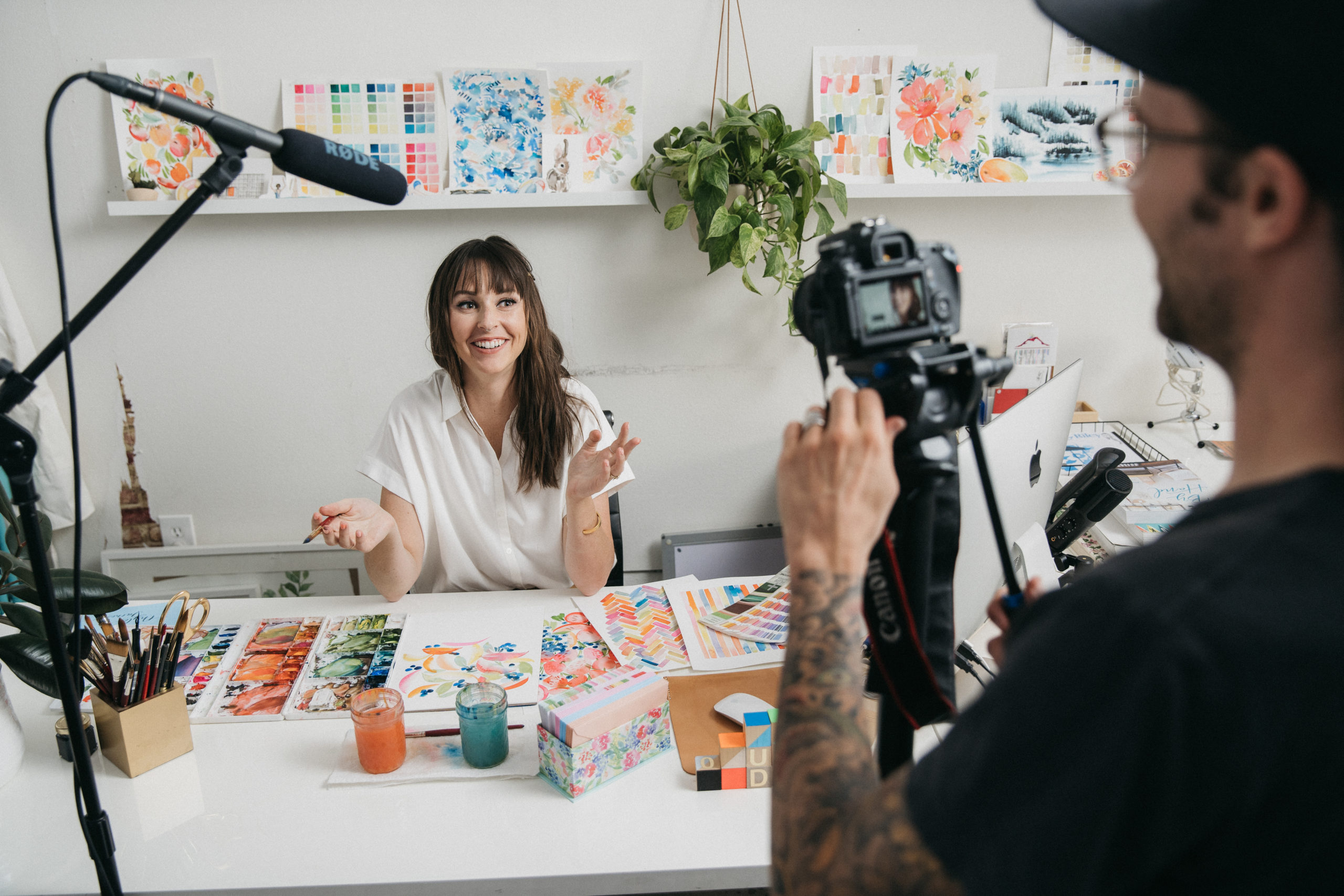Are you thinking about teaching an online course or workshop? Do you want to know what really goes on behind the scenes of a profitable launch?
All of the online courses that I've launched thus far have done six figures during the launch week. I still pinch myself. But I'm not sharing this to boast. Truthfully, my one intention for you is just to see a peek inside what goes into building a profitable online course—whether it's five figures or you make a few hundred extra bucks. I know for some people, a couple thousand dollars a month extra can make a huge impact!
So I want to show you the exact strategies to how it all goes down so you can hopefully implement them into your business if you're teaching online courses.
DISCLOSURE: This post contains affiliate links, which means that if you click on one of the product links and make a purchase, I’ll receive a small commission at no extra cost to you. And you can trust that I only share products I love. This helps to support my work so that I can continue to make valuable free content for you. Thank you for the support!
Where I Teach Online Courses—Then & Now
I started teaching online courses in 2014 with a media website called Brit & Co. I taught floral watercolor, Adobe Illustrator, and intermediate watercolor. Since then I also teamed up with the Crafter’s Box for a painting course and Art Summits for a crest design course and watercolor techniques course.
Skillshare is a really popular platform for hosting courses. I don't have any courses on Skillshare, however, I've taken many Skillshare courses and they're amazing.
With these outside partners, there is usually some sort of affiliate system set up in which for everyone who signs up for the course with your specific link, you get a commission of that sale.
For example, with Brit & Co., I got a percentage of the revenue for sales of my course. With something like Modern Calligraphy Summit or Art Summits, there are seven or eight different instructors within one summit which included one of my courses. Anybody who signed up through my summit promotion I would get 50% commission.
Instead of following these business models and having that revenue share, I started hosting my own courses in 2018. At the time of publishing this post, I have 3 courses and one coming out in March 2020. While it is a whole lot more work hosting a course on your website or through a platform like Kajabi—there’s the benefit of not having to split the revenue.
Build Your Email List
For the first six years of owning my business, I didn't take my email list very seriously. I always had one, but it was just reserved for things like, Hey, I'm teaching a workshop here or I’m selling this now… or just popping in every now and then with a random tidbit of information.
A lot of people—artists and creatives, especially—who have an email list, aren’t always utilizing their email list. It’s doing a huge disservice to your business! I've talked about this before on my 5 Biggest Mistakes as a Creative Entrepreneur episode. If you're scratching your head and you're like, Email is dead! What are you talking about? Nobody checks their email. It's all spam… Incorrect information! Email list marketing probably makes up about 65% of how I generate our income in our business. It is a huge, huge marketing resource and tool.
There's information that I only share with my email list that I don't share anywhere else. So I respect my subscriber’s time and I respect the space that I’m taking up in their inbox. I don't want to spam them.
What the Research Says about Email Marketing:
Here’s the formula you should know about from the research. It's standard that 2% of the people who are subscribed to your newsletter will convert from a sales email.
Here’s an example:
20,000 (subscribers) x 2% = 400 (paying customers)
400 (paying customers) x $50 (online course price) = $20,000. Pretty great, right?!
Compared to social media, where you're battling algorithms and all the noise… You are basically a guarantee in someone's inbox.
And if you're utilizing email marketing in the proper way by giving your subscribers really valuable free information and only selling 20% of the time, they're going to know that every email they open from you isn't spammy. It's content that they want to read because it's really insightful or impactful or it helps them solve some problem.
But what if you have a smaller list? Let's say you have 500 people on your list, times 0.02 equals 10 people in your product is $50. Obviously that math is easy. That's $500 extra per month if you promote something once a month!
It's just like a garden. The more you tend to your newsletter, the more it's going to grow and grow and grow and compound over time. And if you are making it a very valuable place to be, then people are going to want to be subscribed to your newsletter.
Don’t forget about Pinterest which can help skyrocket your email list growth because people are searching for free content on Pinterest. They're searching for the answers to their questions on Pinterest. If you have an opt in for like a free download that answers their questions, then they're going to opt into your email list, download that freebie and be a part of your newsletter. (If you're new to Pinterest, grab my free guide to Pinterest Keyword Research to get you started!)
Grow Your List In Targeted Ways and Segment
The course that I have coming up in March is all about teaching online and in person workshops. And so we are specifically targeting people with interests in teaching with free downloads. We have a free Workshop Cheat Sheet — a checklist of all the steps that it takes to teach and launch and prep for an in person workshop.
We also have a free Creative Workshop Outline Template—my exact outline that I use for all my online classes.
In order to get these freebies, people have to enter their first name and their email and subscribe to my newsletter in order to be sent that specific freebie. And the people that opt in are tagged as “interested in workshops.” So when it comes time to promote the course, I am sending the emails to people who I know are interested in the topic.
Not all people who subscribe to our list are interested in the same topics. Some of them are just there for art specific advice, YouTube tutorial updates, and book releases. They do not want business information. And so those people are segmented or tagged specifically to not receive the business unrelated topics.
Side Note: The tagging is done through our email service provider called Drip. I also really highly recommend ConvertKit because it’s user-friendly and more budget-friendly than Drip.
The Prelaunch Runway
We spend at least two months nurturing our email list with free valuable content. When it does come time to launch, my subscribers have already received at least four emails from me in addition to a freebie email on the topic. The newbies are also getting to know my brand, who I am, what I do and how I'm an expert in whatever certain topic I'm talking about. Especially for a cold audience, you don’t want the first thing out of your mouth to be a sales promotion. I want them to first trust me because I have given them very valuable information.
Even on social media, I'm talking about building this course that I'm really excited about. I'm talking about workshops and how you can make an extra $1,000 to $2,000 in a weekend as an artist or I'm talking about how to make a better course outline so you can be a more confident teacher. I'm talking about specific topics that shares the why behind whatever the course topic is that I'm about to promote so that my audience may become more interested. They become more aware that what I'm about to set them up for is really valuable. And my online course has the steps if they want to achieve the same results.
The goal of the prelaunch runway to not only nurture people to purchase the course, it's also helping them decide and helping me help them decide if they're going to be the right fit for this course or not. It serves nobody if somebody signs up for my course and they're not the right fit. I'm not trying to do any sort of sleazy scammy course promotion to get rich quick. If you're not the right fit for my courses, nobody's going to be happy.
Facebook Advertising
When I launched my very first online course on my own, Pen to Press, I didn't have any Facebook advertising and that course did $104,000 in one week, which I’m still pinching myself over. I was eight months pregnant, I had bronchitis and I had no ad spend—it was all organic through Instagram and my email list. And and at this time with my email list, I didn't have any sort of segmenting going on. I was still using MailChimp.
For the three launches after that, I have had Blake and Derek on my team and they are Facebook and email marketing guru who brought all the expertise on targeting, segmenting, and advertising.
When we're about two to three months out, we start spending money on Facebook advertising—anywhere from $250 a day to $500 a day—for lead generation (promoting an attractive freebie to grow my email list). And then once launch week arrives, we are specifically using our ad spend to sell the course directly.
If this is going over your head again, just remember this was all over my head like roughly a year and a half ago. So just take a deep breath and go at your pace. If you do want to achieve huge results in your business, it might be time to start thinking about Facebook advertising and hiring the right person/ agency for it.
Structure the Course Before Promoting
I like to have about three months if I'm building a course from scratch. I start with an outline of all the modules and lessons within each module and make note of good places for handouts and exercises.
For one of my first online classes, I just kind of spewed out all the information. And we were noticing that people weren’t finishing the videos and instead, skipping around. I realized people may be signing up for only specific lessons. And so all of my courses now are really targeted bits of information. The lessons are shorter and they cover one specific topic. They're easier for me to film because I'm not spending an hour and a half filming an entire video. I'm doing 5-15 minute video lessons within a module. It's still a very obviously very, very in-depth course. It's just the topics and the bite-sized lessons are more targeted.
Once I finish the outline and start filming and creating the handouts, I'm ready to launch the course because I know exactly what's included, making promotion effortless!
Listen to Your Audience
When launch week happens, a lot of people ask questions: Is this going to be covered in the course? Hey, I'm really struggling with this in my workshop teaching. Are you talking about pitching to venues?
Some really great topics could come up that I didn’t have in my outline and I don’t have in my lessons. During the first few days of launch week, I listen. Maybe I can include them as bonuses or as a handout or maybe as an added video lesson. And so I'm adding bits and pieces throughout launch week because so many people are vocal about what they're struggling with or what they may be interested in within the course.
Even though the bulk of the work is done by then, launch week looks very chaotic! I have spreadsheets and Google docs where I'm offloading all of the responses in DMs that I'm getting from my potential customers. That way I can do Facebook lives, Instagram lives, Stories, Q&As, around common questions. There are people, wallflowers on the sidelines, who have the same questions and are just not asking it. And so if I can answer them publicly, then that can convert them to a potential customer as well. These public forums have a direct impact on the sales.
A 7-Day Launch
Seven days does it for me. For my last last launch, I did a 14-day launch and it just felt like eternity. I was exhausted and I feel like my people were exhausted from hearing me talk about this course. And so I really want to protect the people on my email list and the people who follow me on social media.
Seven days is what I did for Pen to Press and I made $104,000. Fast forward to starting to implement Facebook ads and when I hired Blake and Derek for marketing strategy. I launched my licensing course Brand Plus Brand about two months after hiring them. So doing the same prelaunch runway strategy alongside Facebook ads and more targeting, we did a quarter of a million dollars in seven days. Facebook and ramping up your email list directly impact sales!
Launching Each Course Once Per Year
If you’re a fan of Amy Porterfield, you know she talks a lot about launches. The way she markets and goes about her launch strategy has been a direct result of how I've cleaned up my strategy. I only launch each of my 4 courses for one week during the entire year.
I don't want to bombard my audience with sales information. People have become desensitized to sales and promos. They don't even hear it anymore. So the more you talk about, Go purchase this thing or Swipe up! or this or ad or sponsored, the more desensitized to your content your audience is going to be.
Having a cart open and cart close date is beneficial for a few reasons. It drive sales. It creates FOMO. It’s less of a headache. And your audience is only hearing about it for one week out of 52. Those who are tagged and segmented are getting emails every day for a week, including a final reminder email. BTW, we saw a 14% increase in conversions after sending our second to last email of the last two launches that we've done, which ended up being roughly $22,000 increase in sales on the last day.
Shift Your Mindset
If any of this was over your head or made you feel intimidated, I hope that you can turn any discouraged frown upside down and actually reframe your mind a little bit. I hope it encourages you to implement some of these strategies into your own business.
I was in your shoes 2 years ago! People were saying all of this stuff about email marketing and I was like, I don't know what you're talking about or how to do it. I was there in MailChimp trying to figure it out on my own, trying to build those opt in forms and landing pages and trying to figure out how to tag and segment my audience and not send them emails and make them angry and receiving the angry responses when I was sending launch emails from people who are like, I'm only interested in our topics… you get the idea.
I had to figure it out on my own. If I can figure it out, you can figure it out. Start nurturing the people on your email list and start attracting people to your email list because you can get huge results.















It sounds overwhelming but all makes sense! Thank you so much for sharing your experiences, I know I can do this!
I was definitely overwhelmed at first. But you get the hang of it. One step at a time! You can totally do this!
Hi Jenna – great podcast. Do you use Kajabi or another kind of platform for your online courses?
We just started using Kajabi and love it!
Hi Jenna . . .
Just found you through Art Summits and read this content. I am ready to begin an online course to help women with the home & well-being connection. It’s a big leap to commit to this and truly appreciate the info you provided. Truly appreciate your sharing from the heart.
It is a big leap and I’m so excited for your Charrisse! Rooting you on! xo